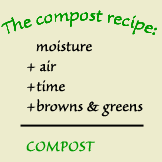Home >>> Waste >> Composting
Composting
 Composting
is the biological decomposition of organic waste such as food or plant
material by bacteria, fungi, worms and other organisms under controlled
aerobic (occurring in the presence of oxygen) conditions. The end result
of composting is an accumulation of partially decayed organic matter
called humus. Composting with worms, also known as vermiculture,
results in nutrient-loaded worm castings.
Composting
is the biological decomposition of organic waste such as food or plant
material by bacteria, fungi, worms and other organisms under controlled
aerobic (occurring in the presence of oxygen) conditions. The end result
of composting is an accumulation of partially decayed organic matter
called humus. Composting with worms, also known as vermiculture,
results in nutrient-loaded worm castings.
Why compost?
- it's easy
- creates a useful soil enricher
- environmentally sound way of reducing yard waste by recycling it where it is generated
Some states, including Florida, have banned yard
wastes from landfills because it takes up space. Yard waste is
such materials as leaves, grass clippings, brush and prunings. Leaves
and grass clippings can also be used as mulch in your garden or landscape.
Yard waste that will be picked up should be bundled or bagged. It will be mulched and available for free at the:
Leveda Brown Environmental Park
5115 NE 63rd AVE
Gainesville, FL 32609
(352) 334-0172, please call first to conform if mulch is available
How does composting work?
Step 1: Choosing the right composting method for you
|
|||||
| Bin/pile composting
|
Worm composting
|
||||
Step 2: Choosing the right location for your compost binConsider how you will get the raw materials to the pile and how the finished compost will be moved to the area it will be used.
|
|||||
Step 3: Decide what to compostWhat goes in the bin? To build a compost pile, simply alternate layers of browns and greens.
|
|||||
Step 4: The composting processThe compost pile should be periodically mixed to incorporate oxygen. Regularly check the internal temperature and turn over the mixture when it reaches 140° F.The compost pile should be built in layers 3-4 inches deep. Composting still happens if the pile is not turned, it just breaks down slowly. |
|||||
Step 5: Using compost around your homeOnce the composting process is complete, the result is a dark, nutrient-rich humus that has many uses:
|
|||||


